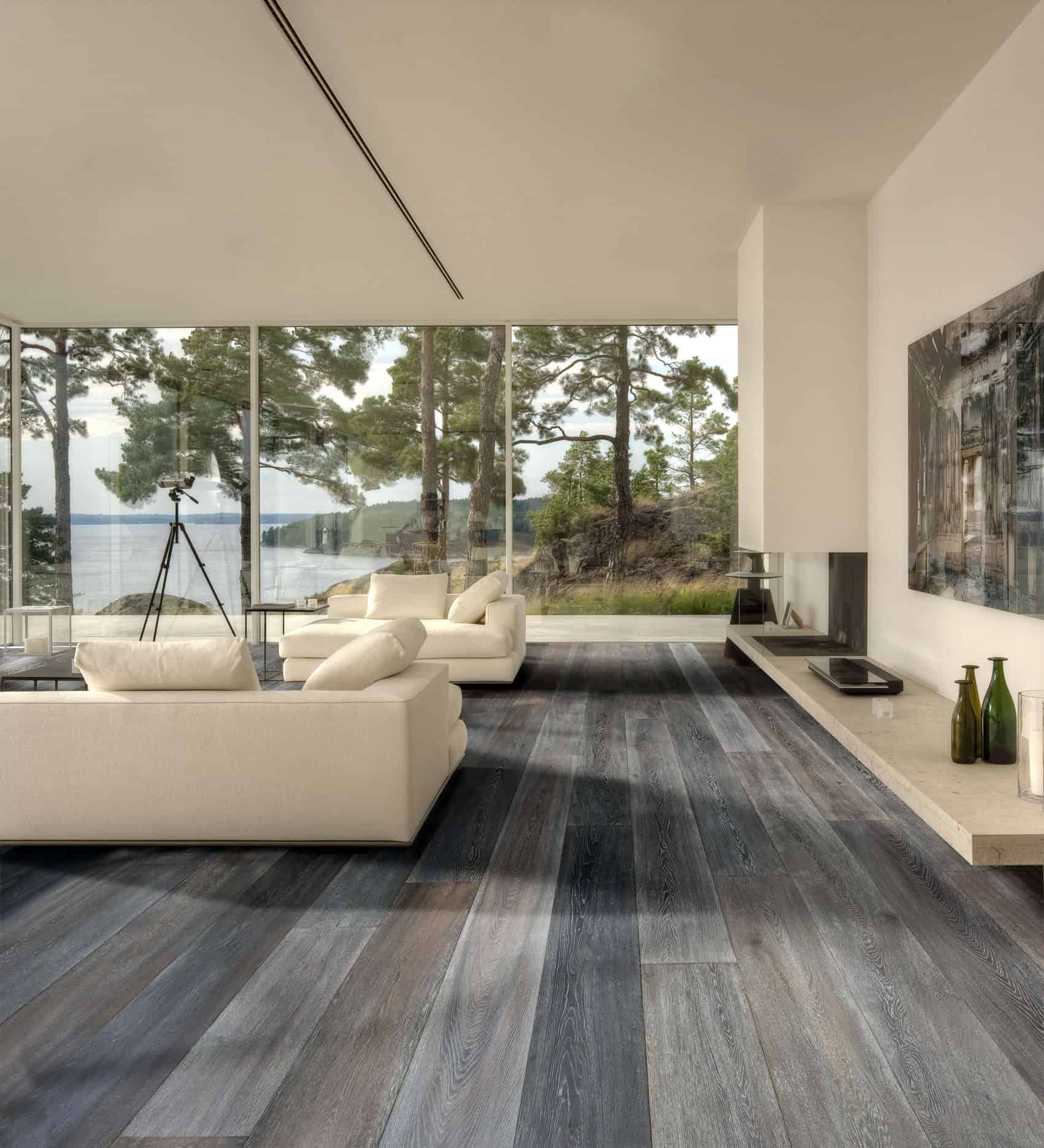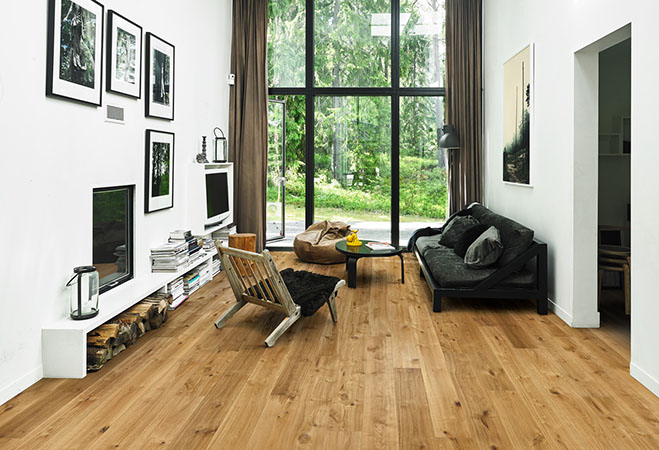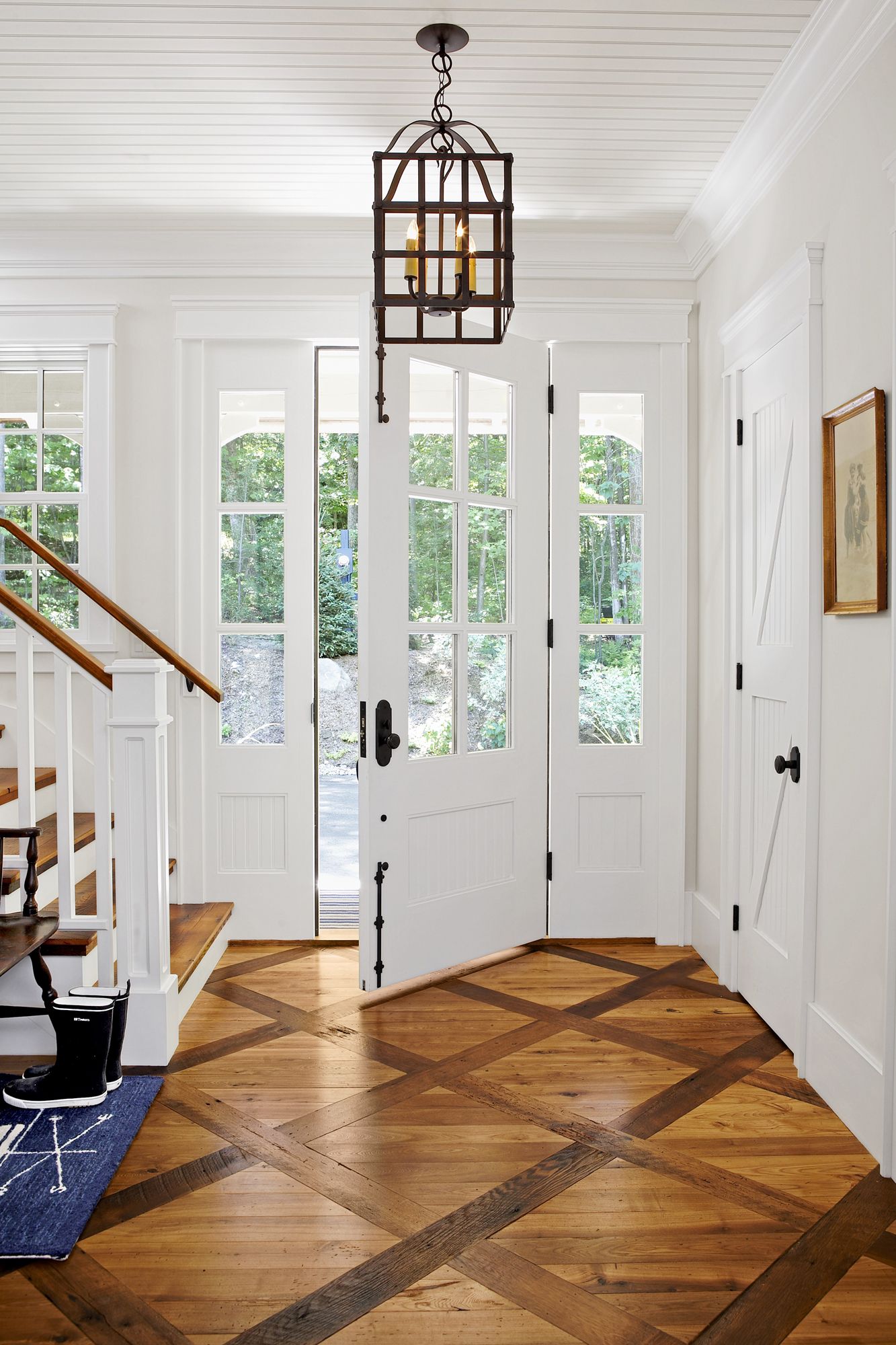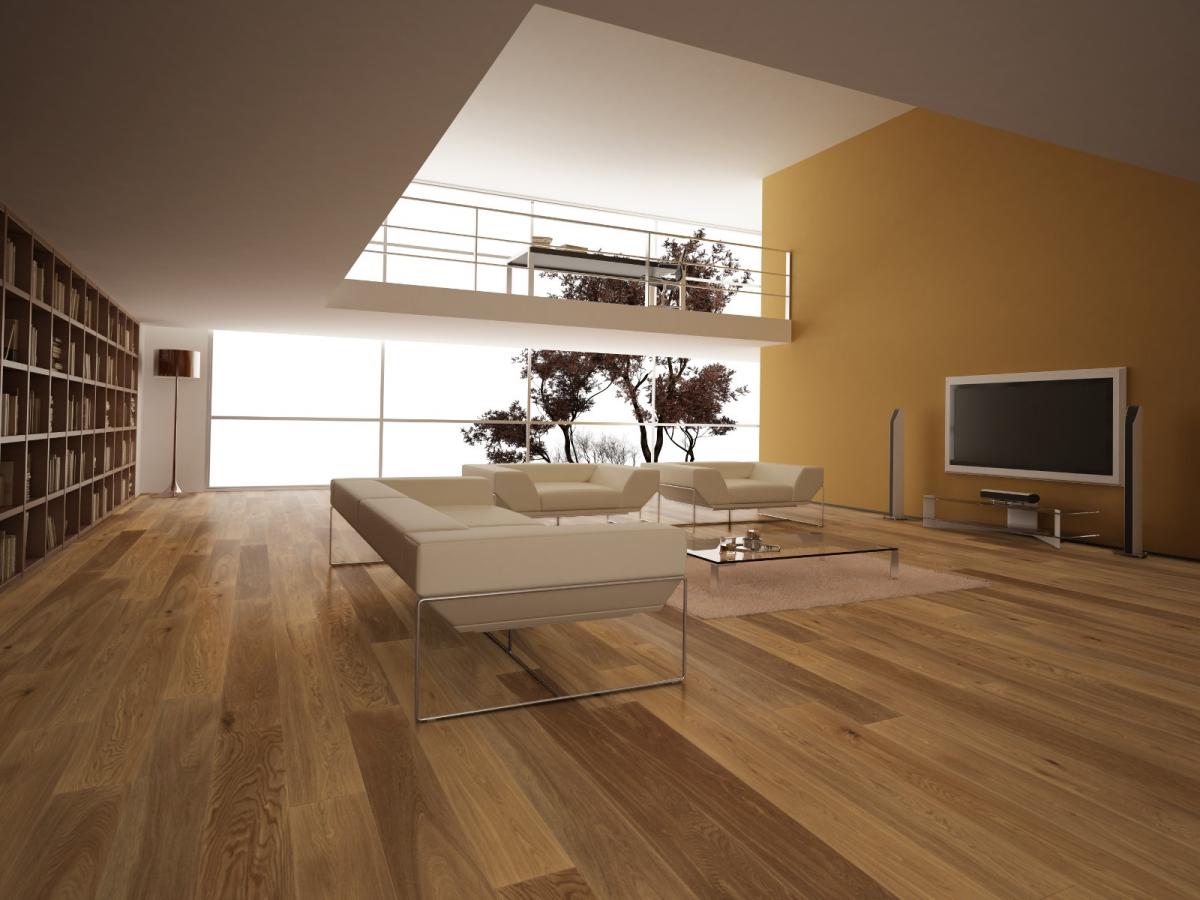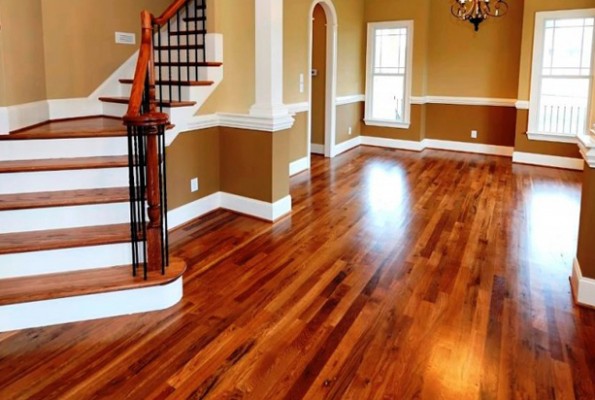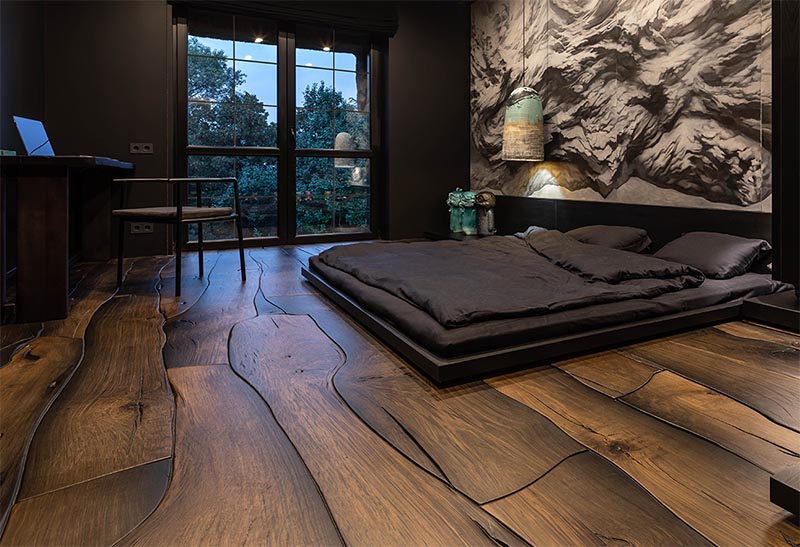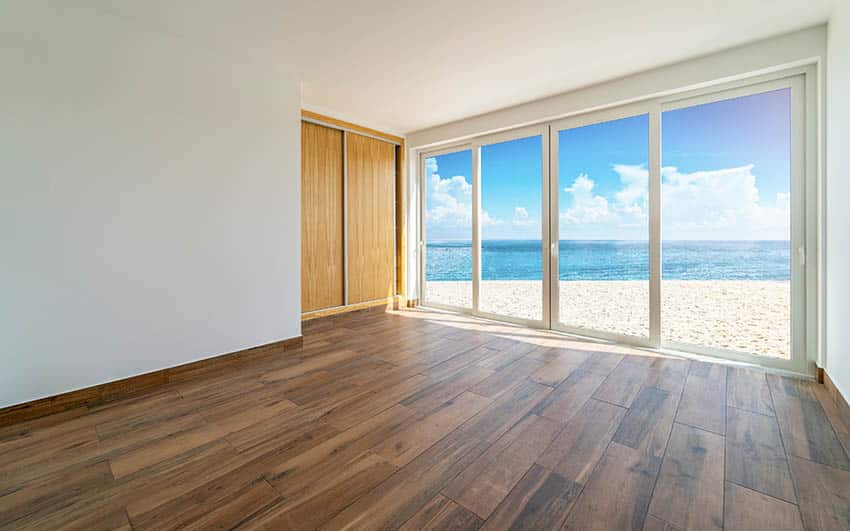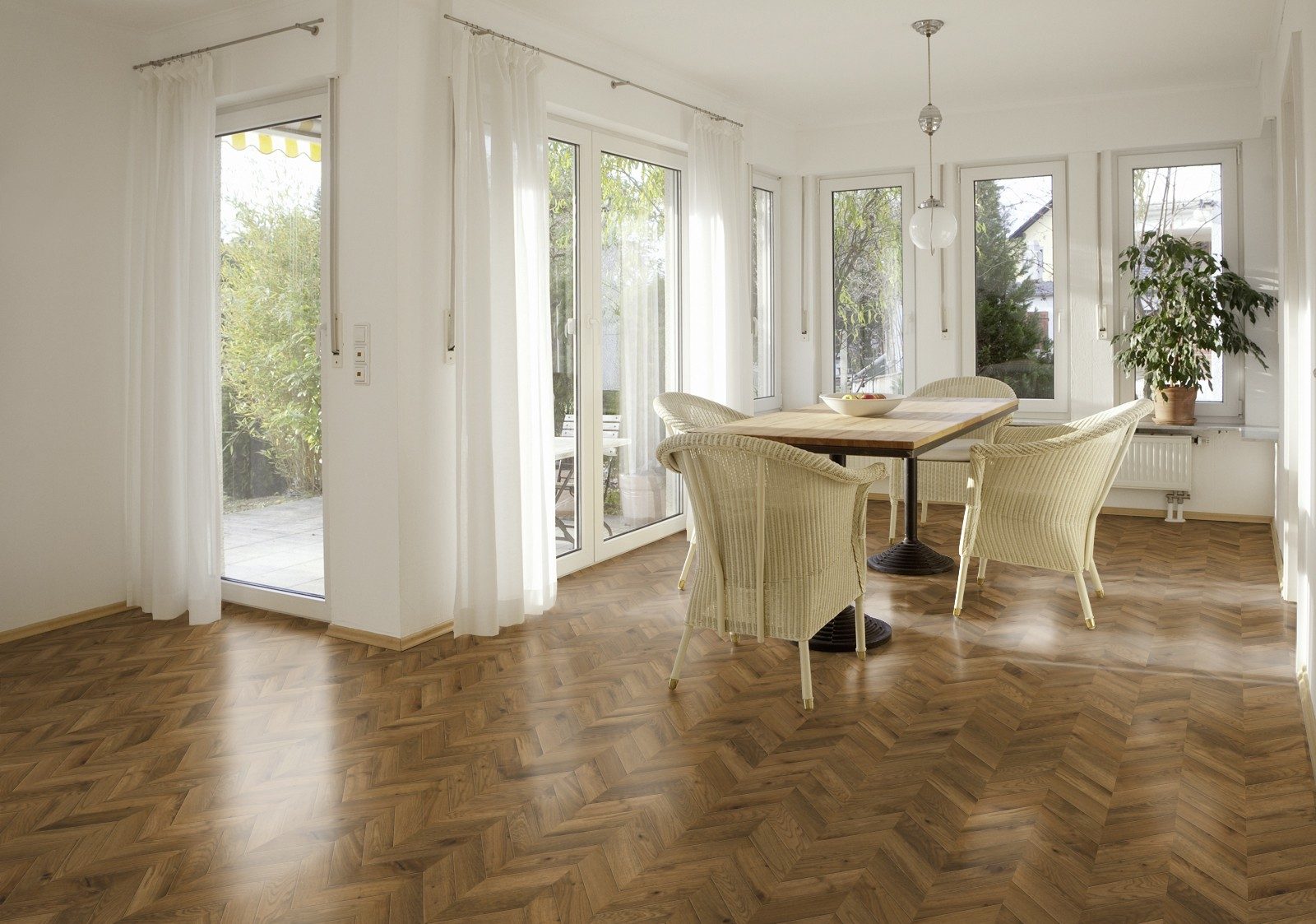The Classic Elegance of Herringbone Wood Floor Pattern
When it comes to timeless flooring designs, the herringbone wood floor pattern stands out as a symbol of classic elegance. Its distinctive V-shaped layout has been a staple in European homes for centuries and continues to be a popular choice for modern interiors.
- Historical Significance: The herringbone pattern dates back to the Roman Empire, where it was used in road construction. Its name comes from its resemblance to the skeleton of a herring fish. This design was later adopted in the grand palaces of Europe, where it became synonymous with luxury and sophistication.
- Visual Appeal: One of the main reasons for the enduring popularity of the herringbone pattern is its visual appeal. The zigzag layout creates a sense of movement and depth, making any room feel more dynamic. This pattern can make a small space appear larger and more open, adding a touch of elegance to any home.
- Versatility: Herringbone wood flooring is incredibly versatile and can complement a variety of interior styles. Whether your home is traditional, contemporary, or somewhere in between, herringbone flooring can add a sophisticated touch. It pairs well with both modern furniture and antique pieces, creating a balanced and harmonious look.
- Installation Considerations: Installing a herringbone pattern requires precision and skill. Each plank must be cut and laid at the correct angle to ensure a seamless fit. While this can be more time-consuming and labor-intensive than other flooring patterns, the end result is well worth the effort. Professional installation is often recommended to achieve the best outcome.
- Material Choices: Herringbone patterns can be created with a variety of wood types, from traditional oak and walnut to more exotic species like teak and mahogany. Each type of wood brings its own unique grain and color variations, allowing you to customize the look to suit your taste and décor.
- Maintenance: Maintaining a herringbone wood floor is relatively simple. Regular sweeping and occasional mopping with a damp cloth will keep the floor looking pristine. It’s also important to use protective pads under furniture to prevent scratches and to address spills promptly to avoid staining.
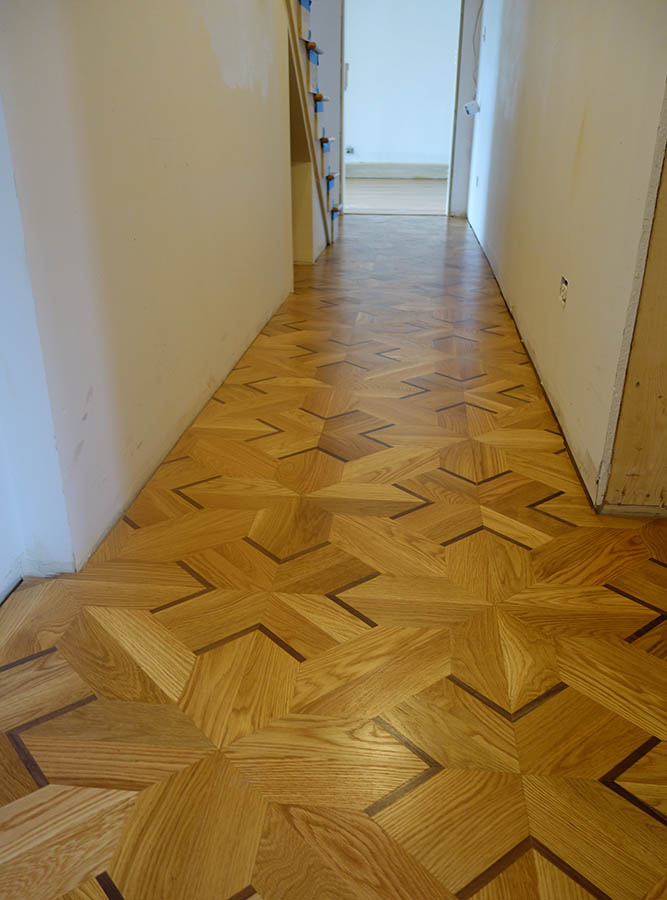
Enhancing Space with Chevron Wood Floor Design
The chevron wood floor design is another classic pattern that has been used for centuries to enhance the beauty of interiors. Its distinctive V-shaped layout is similar to the herringbone pattern but with a key difference that sets it apart.
Distinctive Design: The chevron pattern is created by arranging planks at a 45-degree angle to form a continuous zigzag pattern. Unlike the herringbone, where the planks meet at a right angle, the chevron design involves cutting the planks at an angle so that they join in a point, creating a seamless and uniform look.
Spatial Illusion: One of the most significant benefits of the chevron pattern is its ability to create a sense of space. The diagonal lines draw the eye along the length of the room, making it appear longer and wider. This is particularly beneficial in smaller rooms or narrow hallways where you want to create the illusion of more space.
Modern and Traditional Appeal: Chevron wood flooring can complement both modern and traditional interiors. In contemporary settings, it adds a touch of sophistication and can make a bold design statement. In more traditional homes, it provides a sense of timeless elegance that harks back to classic European design.
Variety of Materials: Like other wood floor patterns, chevron designs can be crafted from a range of wood types. Whether you prefer the warm tones of oak, the rich hues of walnut, or the exotic allure of teak, there is a wood type to suit your taste. Additionally, chevron patterns can be achieved with engineered wood, providing a more affordable option without sacrificing style.
Installation Complexity: Installing a chevron pattern is more complex than standard plank flooring. Each plank must be precisely cut and aligned to create the desired effect. This often requires professional installation to ensure accuracy and a flawless finish. The extra effort and cost are justified by the stunning result.
Maintenance and Care: Chevron wood floors require similar maintenance to other wood flooring types. Regular cleaning with a soft broom or vacuum will keep dust and debris at bay. For deeper cleaning, use a damp mop and a wood-friendly cleaner. As with any wood floor, it’s essential to protect the surface from scratches and moisture to maintain its beauty.
Achieving a Timeless Look with Basketweave Wood Floor Pattern
The basketweave wood floor pattern is a timeless design that adds a touch of sophistication and intricacy to any space. Its distinctive layout mimics the appearance of woven baskets, creating a textured and visually interesting floor.
Intricate Design: The basketweave pattern is composed of small rectangular planks arranged in a square or rectangular grid. Each “basket” consists of two or more planks laid horizontally and vertically, creating a woven effect. This intricate design adds depth and texture to the floor, making it a focal point in any room.
Historical Roots: The basketweave pattern has a rich history, dating back to ancient civilizations. It was commonly used in Roman and Egyptian architecture and has remained a popular choice throughout the centuries. Its enduring appeal lies in its ability to add a sense of craftsmanship and detail to any space.
Versatility in Design: Basketweave wood flooring can be customized to suit various interior styles. It works well in both traditional and contemporary settings, offering a versatile design that complements a range of décor. The pattern can be scaled up or down, with larger “baskets” creating a more dramatic effect and smaller ones providing a subtle, intricate look.
Material Options: This pattern can be created using various wood types, from classic oak and walnut to more exotic species like bamboo and teak. Each wood type offers different grain patterns and color variations, allowing you to choose the perfect material to match your interior design.
Installation Considerations: Installing a basketweave pattern requires precision and expertise. The small planks must be carefully cut and arranged to achieve the desired woven effect. Professional installation is recommended to ensure the pattern is executed correctly and to avoid any issues with alignment or spacing.
Maintenance and Durability: Basketweave wood floors are relatively easy to maintain. Regular sweeping and occasional mopping with a damp cloth will keep the floor looking its best. The intricate pattern can help conceal minor scratches and wear, making it a practical choice for high-traffic areas. As with all wood floors, it’s important to protect the surface from moisture and use protective pads under furniture to prevent damage.
Creating Visual Interest with Diagonal Wood Floor Layouts
Diagonal wood floor layouts are a creative way to add visual interest and a dynamic feel to any room. By laying the planks at an angle rather than parallel to the walls, you can achieve a striking and unique look that enhances the overall design of your space.
Dynamic Aesthetic: The primary appeal of diagonal wood floor layouts is their ability to create a sense of movement and energy in a room. The angled lines draw the eye across the space, making it feel more expansive and lively. This layout is particularly effective in large, open areas where it can add a touch of sophistication and visual intrigue.
Room Transformation: Diagonal wood flooring can transform the look and feel of a room. It breaks away from the conventional straight-line layout, offering a fresh and modern alternative. This pattern can make a small room appear larger by guiding the eye along the diagonal lines, creating the illusion of more space.
Versatility in Application: Diagonal wood floor layouts are versatile and can be used in various room types, from living rooms and dining areas to bedrooms and hallways. This pattern works well with both traditional and contemporary designs, providing a unique touch that complements different interior styles.
Material Choices: This layout can be achieved with various wood types, including oak, maple, walnut, and bamboo. Each type of wood offers different grain patterns and colors, allowing you to customize the look to match your décor. Engineered wood is also a popular choice for diagonal layouts due to its stability and ease of installation.
Installation Complexity: Installing diagonal wood flooring is more complex than standard layouts. It requires precise measurements and cutting to ensure the planks fit correctly and the pattern remains consistent. Professional installation is recommended to achieve the best results and to avoid issues with alignment or spacing.
Maintenance and Care: Maintaining diagonal wood floors is similar to other wood flooring types. Regular sweeping and occasional damp mopping will keep the floor clean and free from dust and debris. As with any wood floor, it’s important to protect the surface from scratches and moisture. Use protective pads under furniture and address spills promptly to maintain the floor’s appearance.
Rustic Charm: The Appeal of Wide Plank Wood Flooring
Wide plank wood flooring is a design choice that brings rustic charm and a sense of spaciousness to any interior. With its broader planks and distinctive look, this type of flooring has gained popularity for its ability to create a warm and inviting atmosphere.
Distinctive Aesthetic: Wide plank wood flooring features planks that are typically 5 inches or wider, compared to the standard 2-3 inch planks. This creates a more expansive and seamless look, emphasizing the natural beauty of the wood grain. The larger surface area allows the grain patterns and knots to be more visible, adding character and uniqueness to each plank.
Historical Appeal: Historically, wide plank flooring was common in early American homes and farmhouses. It was made from old-growth trees, which provided the necessary width and durability. Today, wide plank flooring continues to evoke a sense of history and tradition, making it a popular choice for those seeking a rustic or vintage-inspired look.
Spacious Feel: One of the main benefits of wide plank flooring is its ability to make a room feel larger and more open. The wider planks create fewer seams and joints, resulting in a cleaner and more cohesive appearance. This can enhance the sense of space in both small and large rooms, making them feel more airy and inviting.
Versatility in Wood Types: Wide plank flooring is available in various wood types, including oak, pine, maple, and walnut. Each wood type offers different grain patterns, colors, and levels of hardness, allowing you to choose the perfect material to match your interior design. Reclaimed wood is also a popular choice for wide plank flooring, adding a touch of sustainability and history to your home.
Installation Considerations: Installing wide plank wood flooring requires careful consideration and expertise. The larger planks are more susceptible to expansion and contraction due to changes in humidity and temperature. Proper acclimation, installation, and maintenance are crucial to ensure the floor remains stable and beautiful. Professional installation is often recommended to achieve the best results.
Maintenance and Durability: Wide plank wood floors are relatively easy to maintain with regular sweeping and occasional mopping. The larger surface area can help hide minor scratches and wear, making it a practical choice for high-traffic areas. It’s important to use protective pads under furniture and address spills promptly to prevent damage. With proper care, wide plank flooring can last for many years and continue to add charm and character to your home.
Innovative Designs: Mixed Width and Length Wood Floor Patterns
Mixed width and length wood floor patterns are a contemporary design trend that adds a unique and dynamic touch to any space. By varying the widths and lengths of the planks, you can create a visually interesting floor that stands out from traditional uniform layouts.
Dynamic Aesthetic: The primary appeal of mixed-width and length wood floor patterns is their ability to create a dynamic and visually engaging floor. The variation in plank sizes breaks up the monotony of uniform patterns, adding texture and depth to the room. This design can make the floor a focal point and enhance the overall aesthetic of the space.
Customization Options: Mixed width and length patterns offer endless customization options. You can choose different combinations of plank widths and lengths to suit your style and preferences. This allows you to create a floor that is truly unique and tailored to your interior design. The flexibility in design makes it a popular choice for those looking to make a statement with their flooring.
Material Choices: This pattern can be achieved with various wood types, including oak, maple, walnut, and hickory. Each type of wood offers different grain patterns and color variations, allowing you to create a customized look. Reclaimed wood is also a popular choice for mixed width and length patterns, adding a touch of sustainability and history to your home.
Installation Considerations: Installing mixed width and length wood flooring requires careful planning and precision. The varying sizes of the planks need to be arranged in a way that creates a balanced and cohesive look. Professional installation is often recommended to ensure the pattern is executed correctly and to avoid issues with alignment or spacing.
Versatility in Design: Mixed width and length wood floor patterns are versatile and can complement various interior styles. Whether your home is modern, rustic, or traditional, this pattern can add a unique touch that enhances the overall design. The variation in plank sizes can also help conceal minor imperfections, making it a practical choice for older homes or high-traffic areas.
Maintenance and Care: Maintaining mixed width and length wood floors is similar to other wood flooring types. Regular sweeping and occasional mopping with a damp cloth will keep the floor clean and free from dust and debris. As with any wood floor, it’s important to protect the surface from scratches and moisture. Use protective pads under furniture and address spills promptly to maintain the floor’s appearance.
Combining Functionality and Style with Parquet Wood Flooring
Parquet wood flooring is a sophisticated choice that combines functionality and style to create a unique and elegant look. Its intricate geometric patterns and rich history make it a popular choice for those seeking a timeless and distinctive flooring option.
Geometric Patterns: Parquet flooring is characterized by its geometric patterns, which are created by arranging small wood pieces in a repeating design. Popular parquet patterns include herringbone, chevron, basketweave, and Versailles. These intricate designs add a touch of elegance and sophistication to any space, making the floor a focal point.
Historical Significance: Parquet flooring has a rich history dating back to the 16th century, where it was used in the grand palaces of Europe. Its name comes from the French word “parqueterie,” meaning “small compartment.” Parquet floors were prized for their intricate designs and craftsmanship, and they continue to be a symbol of luxury and refinement.
Versatility in Design: Parquet flooring is incredibly versatile and can complement various interior styles. Whether your home is traditional, contemporary, or somewhere in between, parquet flooring can add a sophisticated touch. The wide range of patterns and wood types allows you to customize the look to suit your taste and décor.
Material Choices: Parquet patterns can be created using various wood types, including oak, walnut, cherry, and maple. Each type of wood offers different grain patterns and colors, allowing you to choose the perfect material to match your interior design. Engineered wood is also a popular choice for parquet flooring, providing stability and ease of installation.
Installation Considerations: Installing parquet flooring requires precision and expertise. The small wood pieces must be carefully cut and arranged to create the desired geometric pattern. This process can be time-consuming and labor-intensive, so professional installation is often recommended to achieve the best results. Proper acclimation and subfloor preparation are also crucial to ensure the floor remains stable and beautiful.
Maintenance and Durability: Parquet wood floors are relatively easy to maintain with regular sweeping and occasional mopping. The intricate patterns can help conceal minor scratches and wear, making it a practical choice for high-traffic areas. It’s important to use protective pads under furniture and address spills promptly to prevent damage. With proper care, parquet flooring can last for many years and continue to add charm and elegance to your home.
This Unique Wood Flooring Fits Together Like Puzzle Pieces
Hardwood Flooring NYC, Wood Flooring New York
Wood Floor Patterns (Layouts & Design Guide) – Designing Idea
Wood Floor Patterns That Never Get Old
Related Posts:
